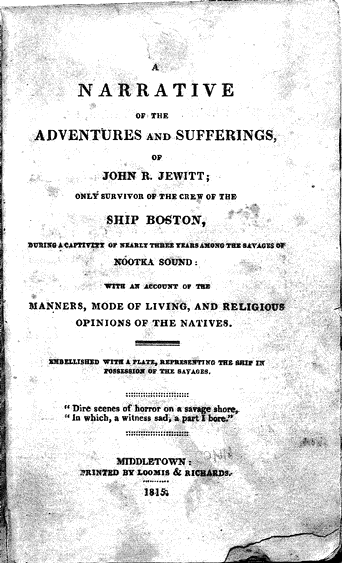
Bridget M. Marshall
University of Massachusetts, Lowell
ALA 2009 Conference Round Table: Teaching 19th Century American Literature
Expanding 19th Century Literature with Web Resources
Links to documents for Presentation
Link to Annotated Bibliography Provided to Students for the Assignment: http://faculty.uml.edu/bmarshall/sourcesdigitaldocument.html
Link to Samples of Student Papers: http://faculty.uml.edu/bmarshall/amlitspring2011.html (page down a bit once you follow the link)
Link to Digital Document Assignment Handout from the presentation: http://faculty.uml.edu/bmarshall/digitaldochandoutALA.html
Expanding 19th Century Literature with Web Resources
I teach the “American Literature I -- Beginnings to Civil War” survey at the University of Massachusetts, Lowell. Tired of my predictable 19th-century texts by the usual suspects -- Longfellow, Poe, Stowe, Thoreau -- and tired of the predictable student papers about these texts, a few semesters ago, I created the “Digital Document Assignment.” Rather than writing about a text that appears in their anthology or on their syllabus, students go online to find and write about a primary document from our survey’s period. I provide them with an online, annotated bibliography of links to primary source web sites, and students search for and choose a document based on their own interests [you can see some samples on the page below].
The assignment is a kind of controlled research project (in that they start from the sources I provide), but it is also incredibly open-ended, allowing students to choose from a nearly unlimited number of topics, genres, and authors. Students write their final paper on their chosen document, and also give short presentations in class. The assignment develops students’ research skills, and their ability to evaluate sources, and also gets them thinking about issues of the literary canon – what’s included and what’s not in our anthology and our course.
Perhaps most importantly to me, I was actually excited about reading a stack of final papers. In many cases, the students discovered new documents that I had never seen. It was fascinating to learn about these documents and the stories behind them. Briefly, I’d like to show a few highlights – documents students have found in the archives for this project.
One student got very excited about his discovery of Richard Alsop’s “Narrative of the Adventures and Sufferings of John R. Jewitt,” which re-tells Jewitt’s story of captivity from 1803 to 1805 with the Nootka tribe of the Pacific Northwest. The student made excellent connections with readings we had done in class, including Mary Rowlandson’s captivity narrative, and the explorer accounts of Cabeza de Vaca and Columbus. He found the Jewett narrative by combing through a huge array of documents and exhibits at the Library of Congress’s American Memory Project, which has proved to be an excellent source of documents on a huge range of topics.

Richard Alsop’s Narrative of the Adventures and Sufferings of John R. Jewitt, which re-tells Jewitt’s story of captivity from 1803 to 1805 with the Nootka tribe of the Pacific Northwest.
From the Library of Congress American Memory Project Exhibit "Westward by Sea: A Maritime Perspective on American Expansion, 1820-1890."
Students found particularly rich resources in the area of slavery and abolition. One student used an advertising broadside for J.W. Barber’s “A History of the Amistad Captives,” which he found at the Gilder Lehrman Institute of American History. The Gilder Lehrman site is a great repository, not only for documents, but also for several interactive features for teachers and students, including videos, slideshows, and podcasts on various historical topics.
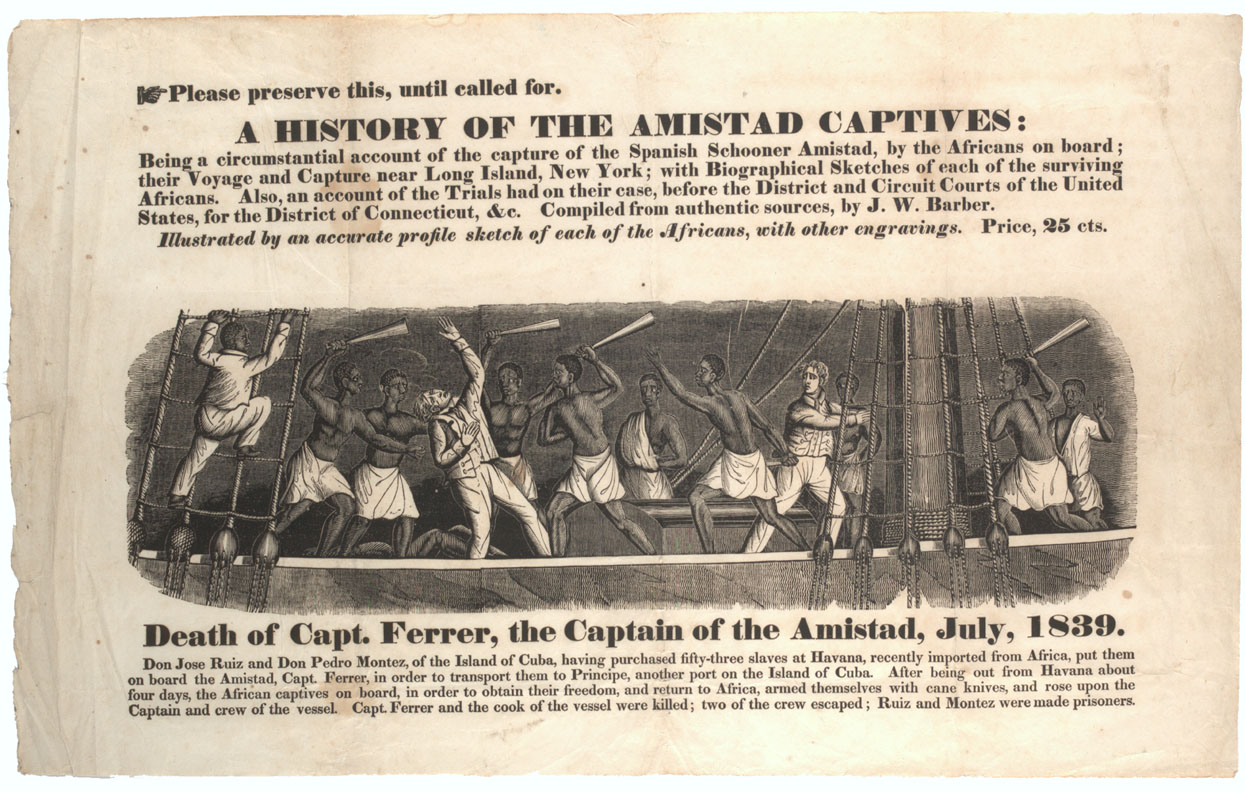
Advertising broadside for J.W. Barber’s A History of the Amistad Captives
From the Gilder Lehrman Institute of American History.
Another student worked on a diary kept by Alice Williamson, a young girl living in Gallatin, Tennessee while the town was occupied by Northern troops. Duke University’s Special Collections Library has put images and transcripts of the diary online. The diary seems particularly important in a class that is lacking in coverage of the South’s perspective on the Civil War.
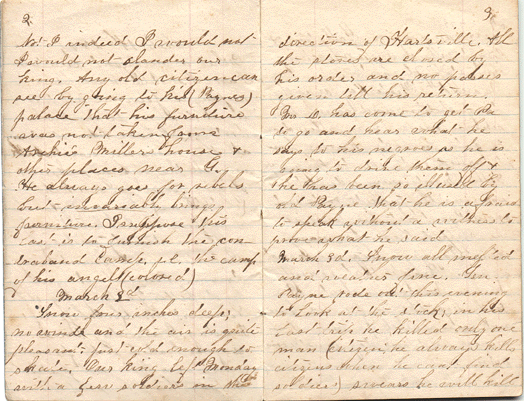
A Diary kept by Alice Williamson, a young girl living in Gallatin, Tennessee in 1864 while the town was occupied by Northern troops.
From Duke University Library Special Collections Exhibit: Civil War Women.
Duke’s collection also includes a series of letters from Rose O’Neal Greenhow, a Confederate spy. I was thrilled to have students discover and write about these texts, which they would never discover in any anthology; I think they gave greater depth to my students’ understanding of the Civil War and its aftermath.
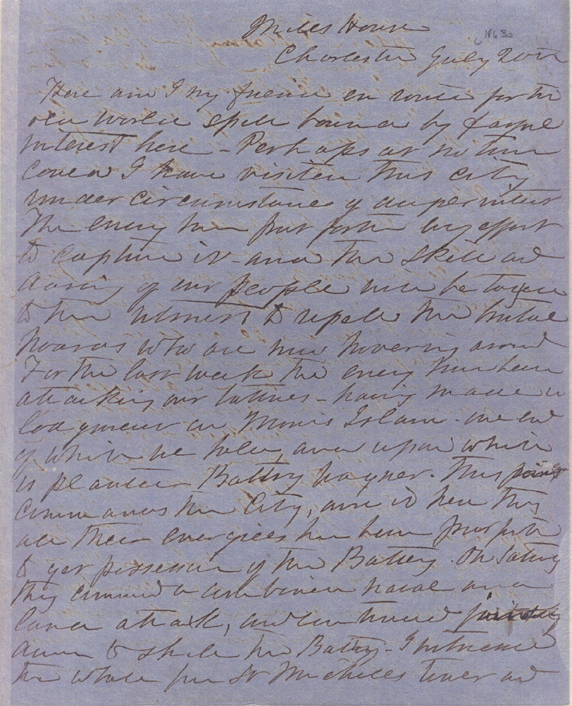
Letters from Rose O’Neal Greenhow, a Confederate spy in the Civil War.
From Duke University Library Special Collections Exhibit: Civil War Women.
For some students, the assignment offered insight into private lives – basically, it gave them the naughty thrill of reading other people’s mail. Many students were fascinated by finds they made in the Massachusetts Historical Society’s archive of the Adams Family Papers, which includes an extensive correspondence between John and Abigail Adams, and the Diary of John Adams.
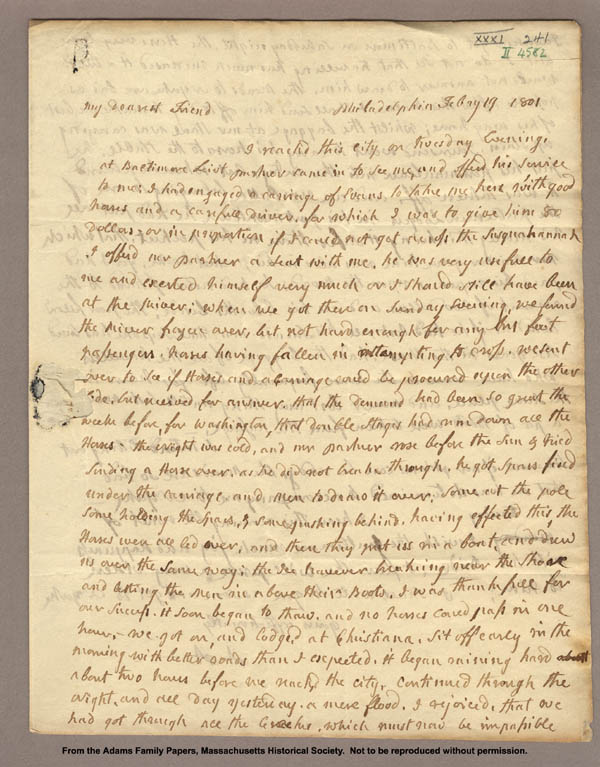
Letter from Abigail Adams to John Adams, 1801.
From the Adams Family Papers: An Electronic Archive by the Massachusetts Historical Society
Several students have been particularly drawn to a series of letters from 1873 by Emma Spaulding Bryant to her husband regarding her medical problems and his suspicion of her infidelity. This is another selection from Duke’s collection, and it’s a somewhat shockingly private letter, in which Bryant describes her visit to a doctor for “uterine complaints,” and then is accused by her husband of sexual impropriety. What seems most remarkable is Bryant’s stern tone of defiance in answering her husband’s accusations; she write in one letter: “Do not dare to write me again, or expect ever to receive another line from me until you can assure me of your unlimited confidence in me and feel sincerely repentant for the terrible things you have said to me. I have never lived with you on other terms than those of the most perfect love and trust and equality. I never intend to live with you on other terms” (August 6th).

Letters by Emma Spaulding Bryant (1873) to her husband regarding her medical problems and his suspicion of her infidelity.
From Duke University Library Sallie Bingham Center for Women's History and Culture.
This semester, I have a student who is writing about an advertisement for a “Safety Casket” from Baltimore, Maryland in 1844. This particular image is from another Duke collection, this one focused on the development of advertising in America. Unsurprisingly, the student has made connections with Edgar Allan Poe’s works and this advertisement, which she has combined with an 1843 patent application for a “Life-Preserving Coffin,” which she found through the National Archives.

An advertisement for a “Safety Casket” from Baltimore, Maryland in 1844.
From Duke University Special Collection The Emergence of Advertising in America.
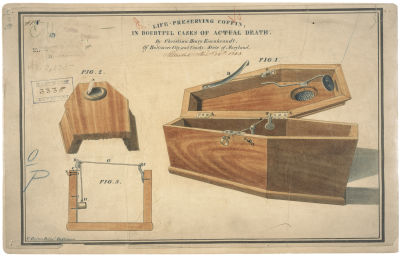
Patent application drawing for a "Life-Preserving Coffin" 1843.
From the National Archives Digital Vaults Collection.
For the last two class meetings of our semester, students do short presentations on their document finds. We move chronologically through the documents, and students are usually pleasantly surprised to hear about the documents that other students have found, and the interesting connections they have made with our course readings. I’ve found it to be an enjoyable assignment, both for students doing the projects and for me, when I’m grading them. Each semester students introduce me to texts that I then recycle and introduce to my next semester’s class. The project helps me to continually update my understanding of American Literary history, and my syllabus for the course.
Updated May 28th, 2009.